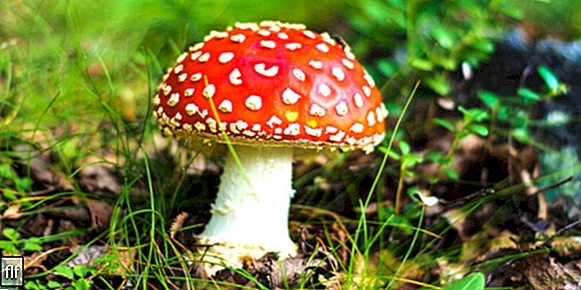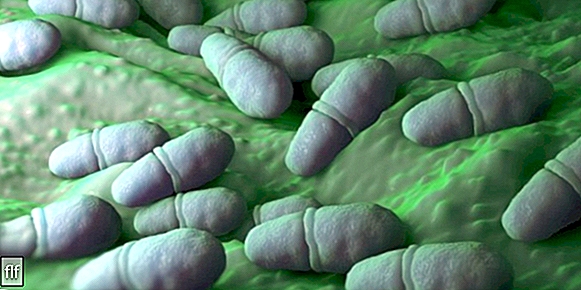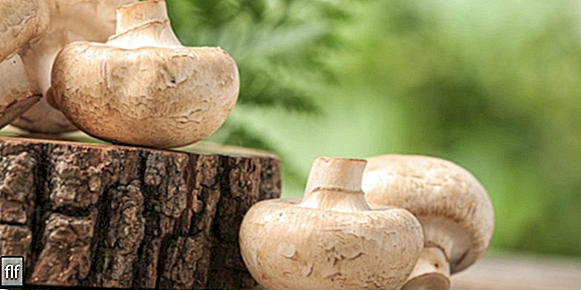- What is the fungi kingdom?
- Characteristics of the fungi kingdom
- Classification of the fungi kingdom
- Nutrition of the fungi kingdom
- Reproduction of the fungi kingdom
- Importance of the fungi kingdom
- Toxic or poisonous mushrooms
- Examples of the fungi kingdom
We explain what the fungi kingdom is, what its characteristics and classification are. Also, how is their nutrition, reproduction and examples.

What is the fungi kingdom?
The fungi kingdom is one of the groups in which the biology classify known life forms. It is made up of more than 144,000 different species of mushrooms, among which are the yeasts, molds and mushrooms, and which share fundamental characteristics such as immobility, heterotrophic feeding and certain cellular structures.
Fungi exist all over the world and in different habitats, and appear in different forms and presentations.
Of all the fungi that inhabit our planet, only 5% have been studied and classified, and it is estimated that there are around 1.5 million species still unknown. This is partly because mushrooms were once classified as a type of plant, until in the 19th century they began to be distinguished as a biological kingdom besides.
The science specializing in members of the fungi kingdom is called mycology.
Characteristics of the fungi kingdom

The members of the fungi kingdom share the following fundamental characteristics:
- They lack mobility of their own. Fungi grow in I usually, on surfaces, or on logs or organic material decomposing, depending on your preferences. Like plants, they remain in the same place all their lives, unable to move at will.
- They have a cell wall. Fungal cells are eukaryotes, that is, they have a cell nucleus In addition, they have a rigid cell wall, similar to that of vegetables cells, but instead of being made of cellulose, it is made of chitin, the same substance that gives insects the toughness of their exoskeletons. In addition, they are elongated cells, which may contain several nuclei, and have vacuoles but no chloroplasts, since they do not photosynthesis.
- They grow as hyphae. Fungal growth occurs as hyphae structures cylindrical and uniform that can range from a few micrometers to several centimeters in diameter. length, and can overlap in a branching or bifurcation process. As the hyphae grow, they form a tangled mass or network-like tissue called mycelium.
- They absorb food from the environment. Fungi do not take food and then digest it in the body like animals. Instead, they infiltrate a food source and secrete digestive enzymes into it. Digestion takes place outside the body. When molecules When complex cells are broken down into smaller compounds, the fungi absorb the predigested food into their body.
- They reproduce by spores. Spores are microscopic reproductive cells that can develop into new organisms. They are generally produced in specialized aerial hyphae or fruiting structures. The structures where spores are produced are called sporangia. The aerial hyphae of some fungi produce spores in large, complex reproductive structures known as "fruiting" bodies. The familiar part of a mushroom is a large fruiting body.
Classification of the fungi kingdom
The classification of fungi has been reworked throughout the history of biology, as better recognition techniques are developed and fungi are distinguished from other life forms that resemble them. The current classification of the kingdom is as follows:
- Basidiomycete fungi (Basidiomycota).They develop setae (basidiocarps), from which the reproductive spores of the fungus are born.
- Ascomycete fungi (Ascomycota). Instead of setae they have asci, spore-producing sex cells.
- Glomeromycete fungi (Glomeromycota). They are mycorrhizae, that is, symbiotic unions between a fungus and the roots of a plant. The fungus provides nutrients and water, and the roots provide carbohydrates and vitamins that the fungus cannot synthesize.
- Zygomycete fungi (Zygomycota). They are molds that form zygospores, that is, spores capable of withstanding adverse conditions for a long time until they can finally germinate.
- Chytridiomycete fungi (Chytridiomycota). They are microscopic and primitive fungi, generally aquatic, that reproduce by flagellated spores (zoospores).
Nutrition of the fungi kingdom

The nutrition of fungi is always heterotrophic, that is, they cannot generate their own food like plants, but must decompose organic matter from other forms of plant or animal life. Depending on how their nutrition is, there are different types of mushrooms:
- saprophytic fungi. They feed on the decomposition of organic matter remains of other organisms (corpses and body waste), whether specific or not, that is, of a certain exclusive type of organic matter or of any in general.
- Mycorrhizal. They are nourished by symbiotic relationship with the plants, colonizing their roots and exchanging with them water and different mineral nutrients, generated by the fungus, in exchange for carbohydrates and vitamins that the fungus is unable to synthesize on its own. This is known as mycorrhiza.
- Lichenized. They are nourished through symbiotic relationships resulting from the union of the fungus and an algae or cyanobacterium, which establish such a close relationship that they can be considered the same individual.They are similar to mycorrhizal.
- parasites They feed directly on the body of others living beings, and for that they can settle on its surface or colonize the interior of its body, which causes various damage to these organisms that can be mild or even lethal.
Reproduction of the fungi kingdom
Fungi reproduce sexually and asexually, always through the production of spores: forms resistant to environment that, when the optimal conditions are met, germinate and create a new specimen of the fungus. The growth of the hyphae, once the spores have germinated, can be very fast: a tropical fungus grows about 5 mm per minute.
Spores are formed as the last part of processes of asexual reproduction (mitosis) either sexual (meiosis), depending on whether the fungus needs to spread quickly, for which asexual replication is preferable, or if it requires genetic variation, for which it will require the exchange of genetic material with other individuals of the same species.
asexual reproduction of fungi
Unicellular fungi, such as yeasts, reproduce asexually through a process called budding—the formation of buds that project from the parent cell.
In the case of multicellular fungi, asexual spores (called conidia) are produced by mitosis in specialized hyphae called conidiophores and are then released into the fungus. air either Water.
sexual reproduction of fungi
Many species of fungi reproduce sexually with various types of mating. In contrast to most of the animal cells and plants, most fungal cells contain haploid nuclei (nuclei with a single set of chromosomes). In sexual reproduction, the process consists of:
- The hyphae of two genetically compatible mating types meet, and their cytoplasms in a process called plasmogamy.
- The resulting cell has two haploid nuclei: one from each fungus.
- This cell gives rise by mitosis to other cells with two nuclei. At some point the two haploid nuclei fuse. This process, called karyogamy, results in a cell that contains a diploid nucleus known as a zygote nucleus. In some groups, the zygote nucleus is the only diploid nucleus.
In the two largest groups of fungi, the Ascomycetes and the Basidiomycetes, plasmogamy (fusion of hyphae) occurs, but karyogamy (fusion of the two different nuclei) does not immediately follow. For a while the nucleus remains separate within the fungal cytoplasm.
Hyphae that contain two genetically distinct but sexually compatible nuclei within each cell are described as dikaryotic. This condition is referred to as n + n instead of 2n, because there are two separate haploid nuclei.
Hyphae that only contain one nucleus per cell are described as monokaryotic. The presence of a dikaryotic stage is an important defining characteristic of ascomycetes and basidiomycetes.
Importance of the fungi kingdom

Fungi carry out an important ecological role in their various niches of appearance, because they help decompose and recycle organic matter (dead animals or plants, defecation, dry and fallen leaves, felled tree trunks, etc.) together with with the bacteria and certain species of insects.
On the other hand, many species of fungi are useful by human being, either as edible species, such as mushrooms, or as decorative species in gardening. Yeasts, meanwhile, are essential in the processes of making beer, bread and other products because they execute the biochemical transformation of substances.
Toxic or poisonous mushrooms
There are species of fungi that secrete dangerous toxins, some can even be lethal if ingested, or if their spores are breathed in. These enzymes Toxic substances can induce in humans or other animals conditions such as tachycardia, vomiting, colic, cold sweat, thirst, bloody stools or even blood pressure decompensation, depending on the amount consumed.
These effects can lead to necrotic damage to the liver and kidneys, which can lead to death if not treated properly. In other cases the toxic effects are mild and may be hallucinogenic.
There is no simple rule to distinguish poisonous mushrooms from edible ones.
Examples of the fungi kingdom

Some common examples of fungi are:
- Beer yeast. (Saccharomyces cerevisiae). It is used in the manufacture of bread, beer and wine.
- The champignon mushroom (Agaricus bisporus). It is grown on farms and is part of the regular diet in many countries.
- Athlete's foot fungus (Trichophyton rubrum). It is one of the 42 species of parasitic fungi that can infect human skin when it is constantly subjected to humidity.
- The Indian bread fungus (Cyttaria harioti). It is a species that parasitizes the trunks of trees in the American South (Chile and Argentina), and generates yellowish tumors or "knots" that obstruct the sap ducts, as well as edible fruits called "Indian bread".
- The corn fungus (Ustilago maydis). Also called huitlacoche or cuitlacoche, it is a fungus that grows between the grains of corn, and generates edible structures that in Mexico and other countries are considered a delicacy.
